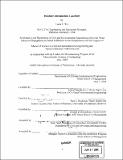| dc.contributor.advisor | David Simchi-Levi and Sara L. Breckman. | en_US |
| dc.contributor.author | Wu, Lucia T. (Lucia Teresa), 1977- | en_US |
| dc.contributor.other | Leaders for Manufacturing Program. | en_US |
| dc.date.accessioned | 2006-11-08T16:30:19Z | |
| dc.date.available | 2006-11-08T16:30:19Z | |
| dc.date.copyright | 2004 | en_US |
| dc.date.issued | 2004 | en_US |
| dc.identifier.uri | http://hdl.handle.net/1721.1/34743 | |
| dc.description | Thesis (S.M.)--Massachusetts Institute of Technology, Dept. of Civil and Environmental Engineering; and, (M.B.A.)--Massachusetts Institute of Technology, Sloan School of Management; in conjunction with the Leaders for Manufacturing Program at MIT, 2004. | en_US |
| dc.description | Includes bibliographical references (p. 77). | en_US |
| dc.description.abstract | Submitted to the Department of Civil and Environmental Engineering and the Sloan School of Management on May 7, 2004 in partial fulfillment of the Requirements for the Degrees of Master of Science in Civil and Environmental Engineering and Master of Business Administration ABSTRACT Many computer companies are seeking to grow their customization capability. As the market becomes increasingly commoditized, computer companies view customization as a way to differentiate their products and offer customer value. However, the implementation of customization programs has been difficult for many organizations. Sun Microsystems launched a customization program called Customer Ready Systems (CRS) through a grass-roots effort in manufacturing. CRS offered assemble-to-order, factory-integrated systems. Although CRS revenues had been growing, scalability was difficult and costs were increasing. CRS needed to evaluate its process and supply-chain from a strategic perspective to ensure alignment with the rest of the organization. To grow profitably, it also needed to reduce costs and increase scalability. This thesis focuses first on the question of whether or not Sun should reconfigure its supply chain to perform more, if not all, of its customization work at external manufacturers. It then turns to the question of whether or not the current internal customization process can be improved, and identifies two opportunities: pricing and process improvement in component removal for reconfiguration, and lead-time variability reduction. | en_US |
| dc.description.abstract | (cont.) This thesis recommends organizational and tactical policies to improve the customization based on these analyses and implementation efforts. The research for this thesis was conducted during a seven month internship with Sun Microsystems' Worldwide Operations group and was affiliated with the Massachusetts Institute of Technology's Leaders for Manufacturing program. | en_US |
| dc.description.statementofresponsibility | by Lucia T. Wu. | en_US |
| dc.format.extent | 77 p. | en_US |
| dc.format.extent | 3708564 bytes | |
| dc.format.extent | 3708371 bytes | |
| dc.format.mimetype | application/pdf | |
| dc.format.mimetype | application/pdf | |
| dc.language.iso | eng | en_US |
| dc.publisher | Massachusetts Institute of Technology | en_US |
| dc.rights | M.I.T. theses are protected by copyright. They may be viewed from this source for any purpose, but reproduction or distribution in any format is prohibited without written permission. See provided URL for inquiries about permission. | en_US |
| dc.rights.uri | http://dspace.mit.edu/handle/1721.1/7582 | |
| dc.subject | Civil and Environmental Engineering. | en_US |
| dc.subject | Sloan School of Management. | en_US |
| dc.subject | Leaders for Manufacturing Program. | en_US |
| dc.title | Building customization capability | en_US |
| dc.type | Thesis | en_US |
| dc.description.degree | M.B.A. | en_US |
| dc.description.degree | S.M. | en_US |
| dc.contributor.department | Leaders for Manufacturing Program at MIT | en_US |
| dc.contributor.department | Massachusetts Institute of Technology. Department of Civil and Environmental Engineering | |
| dc.contributor.department | Sloan School of Management | |
| dc.identifier.oclc | 56131735 | en_US |
